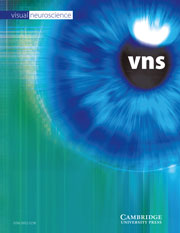Crossref Citations
This article has been cited by the following publications. This list is generated based on data provided by
Crossref.
Ortega, F.
Hennequet, L.
Sarría, R.
Streit, P.
and
Grandes, P.
1995.
Changes in the pattern of glutamate-like immunoreactivity in rat superior colliculus following retinal and visual cortical lesions.
Neuroscience,
Vol. 67,
Issue. 1,
p.
125.
Montero, Vicente M.
and
Jian, Shi
1995.
Induction of c-fos protein by patterned visual stimulation in central visual pathways of the rat.
Brain Research,
Vol. 690,
Issue. 2,
p.
189.
P�rez-Cerd�, Fernando
Mart�nez-Mill�n, Luis
and
Matute, Carlos
1996.
Anatomical evidence for glutamate and/or aspartate as neurotransmitters in the geniculo-, claustro-, and cortico-cortical pathways to the cat striate cortex.
The Journal of Comparative Neurology,
Vol. 373,
Issue. 3,
p.
422.
Tieman, Suzannah Bliss
and
Tieman, David G.
1996.
N-acetylaspartylglutamate immunoreactivity in human retina.
Vision Research,
Vol. 36,
Issue. 7,
p.
941.
Jeffery, Glen
Sharp, Claudia
Malitschek, Barbara
Salt, Thomas E.
Kuhn, Rainer
and
Knöpfel, Thomas
1996.
Cellular localisation of metabotropic glutamate receptors in the mammalian optic nerve: a mechanism for axon-glia communication.
Brain Research,
Vol. 741,
Issue. 1-2,
p.
75.
Mize, R. Ranney
and
Butler, Grace D.
1996.
Postembedding immunocytochemistry demonstrates directly that both retinal and cortical terminals in the cat superior colliculus are glutamate immunoreactive.
The Journal of Comparative Neurology,
Vol. 371,
Issue. 4,
p.
633.
Salt, T.E.
and
Eaton, S.A.
1996.
Functions of ionotropic and metabotropic glutamate receptors in sensory transmission in the mammalian thalamus.
Progress in Neurobiology,
Vol. 48,
Issue. 1,
p.
55.
Repérant, J.
Rio, J.-P.
Ward, R.
Wasowicz, M.
Miceli, D.
Medina, M.
and
Pierre, J.
1997.
Enrichment of glutamate-like immunoreactivity in the retinotectal terminals of the viper Vipera aspis:.
Journal of Chemical Neuroanatomy,
Vol. 12,
Issue. 4,
p.
267.
Repérant, J.
Rio, J.-P.
Wasowicz, M.
Ward, R.
and
Miceli, D.
1997.
Differential glutamate immunoreactivity in glial cells of the retino-recipient layer of the viper optic tectum following retinal ablation. A quantitative EM immunogold study.
Brain Research,
Vol. 761,
Issue. 2,
p.
321.
Eri?ir, Alev
Van Horn, Susan C.
Bickford, Martha E.
and
Sherman, S. Murray
1997.
Immunocytochemistry and distribution of parabrachial terminals in the lateral geniculate nucleus of the cat: A comparison with corticogeniculate terminals.
The Journal of Comparative Neurology,
Vol. 377,
Issue. 4,
p.
535.
Kenigfest, N.B.
Rep�rant, J.
Rio, J.-P.
Belekhova, M.G.
Ward, R.
Vesselkin, N.P.
Miceli, D.
and
Herbin, M.
1998.
Retinal and cortical afferents to the dorsal lateral geniculate nucleus of the turtle,Emys orbicularis: A combined axonal tracing, glutamate, and GABA immunocytochemical electron microscopic study.
The Journal of Comparative Neurology,
Vol. 391,
Issue. 4,
p.
470.
Jones, E.G.
1998.
The Primate Nervous System, Part II.
Vol. 14,
Issue. ,
p.
1.
Ding, Y.
and
Casagrande, V.A.
1998.
Synaptic and neurochemical characterization of parallel pathways to the cytochrome oxidase blobs of primate visual cortex.
The Journal of Comparative Neurology,
Vol. 391,
Issue. 4,
p.
429.
Sáez, J. A.
Palomares, J. M.
Vives, F.
Domínguez, I.
Villegas, I.
Montes, R.
Price, D. J.
and
Ferrer, J. M. R.
1998.
Electrophysiological and neurochemical study of the rat geniculo‐cortical pathway. Evidence for glutamatergic neurotransmission.
European Journal of Neuroscience,
Vol. 10,
Issue. 9,
p.
2790.
Wörgötter, F.
Nelle, E.
Li, B.
and
Funke, K.
1998.
The influence of corticofugal feedback on the temporal structure of visual responses of cat thalamic relay cells.
The Journal of Physiology,
Vol. 509,
Issue. 3,
p.
797.
Gundersen, V.
and
Storm-Mathisen, J.
2000.
Glutamate.
Vol. 18,
Issue. ,
p.
45.
Montero, Vicente M
Wright, Lynda S
and
Siegel, Frank
2001.
Increased glutamate, GABA and glutamine in lateral geniculate nucleus but not in medial geniculate nucleus caused by visual attention to novelty.
Brain Research,
Vol. 916,
Issue. 1-2,
p.
152.
Land, Peter W.
and
Shamalla‐Hannah, Lorraine
2001.
Transient expression of synaptic zinc during development of uncrossed retinogeniculate projections.
Journal of Comparative Neurology,
Vol. 433,
Issue. 4,
p.
515.
Shostak, Yuri
Ding, Yuchuan
and
Casagrande, Vivien A.
2003.
Neurochemical comparison of synaptic arrangements of parvocellular, magnocellular, and koniocellular geniculate pathways in owl monkey (Aotus trivirgatus) visual cortex.
Journal of Comparative Neurology,
Vol. 456,
Issue. 1,
p.
12.
Yasuhara, Osamu
Tooyama, Ikuo
Aimi, Yoshinari
Bellier, Jean-Pierre
Hisano, Tadashi
Matsuo, Akinori
Park, Masami
and
Kimura, Hiroshi
2003.
Demonstration of Cholinergic Ganglion Cells in Rat Retina: Expression of an Alternative Splice Variant of Choline Acetyltransferase.
The Journal of Neuroscience,
Vol. 23,
Issue. 7,
p.
2872.

